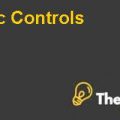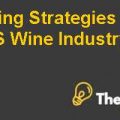Problem Statement
The company, Rio Tin to, is having the bad perceptions about its past record over sustainability. The negative word of mouth spread on a large scale that the company is having poor records over the decades on the sustainability agenda. This acts as a challenge for the company and affects negatively on the interest of the company’s operations. Any public listed companythathas a bad record in any business aspect, cannot be fully successful in its business as the stakeholders are not happy over its record which in turn affects its bottom line and market capitalization
The CEO, Paul Skinner was neck to neck with the challenge of increasing public profile of the company. It was being contemplated whether the company should focus over the sustainability agenda or not? If they just ignore this agenda, what would be repercussions for the company? Should they only take into account the basic business issues of the company? If they continue taking measures for sustainability development, will it make financially sound case to pursue it or not?Therefore, the problem lies in taking decision about the sustainability agenda by taking in account the pros and cons of the decision for the company’s future.
Analysis of the Issues
Therefore, while analyzing the issues, it is imperative to use the SWOT analysis in order to get the true picture of the issues.
SWOT Analysis
Strengths
- The group has a competitive advantage in its area of expertise, which is exploring, mining and processing materials.
- The group has a widespread business activity in all continents of the world except Antarctica.
- In today’s connected and competitive world, sharing of knowledge is good. The competitive landscape between companies will be strengthened if the companies share knowledge in this today’s modern world. Rio Tinto has made a joint venture with another competitive firm BHP Billiton in Chile, which makes the collaboration fruitful for both companies. It will help to share intellectual capital of the qualified human resource, brings down rivalry among the firms, reduce the wastage of resources as comparison to the situation where both the firms are doing business separately.
- It is doing what is called the very best practices in safety, ethics, CSR and sustainable development.
- They have ventured into rich mines which have life of over, say e.g. 40 years and above.
- Due to the scope of the business in terms of geography, its large size and its nature, it has a large impact on the environment and communities in which it operates, especially in underdeveloped areas of the world.
- Due to excessive workload, there is high attrition rate in the company.
- There are untapped resources, which are mostly located in far off regions. They are rich in minerals, which poses a good opportunity for the company’s business.
- Due to the limited resources available, the company can enjoy higher prices of metals it extracts, which is good for business.
- The rich deposits that are untapped pose a serious problem as their exploration and exploitation is very challenging and dearer.
- There is a possibility that if the sufficient volume of metals and minerals are not found or their prices fuel further inflation, then there is possibility that the substitutes may emerge.
- Mineral extracting industries are increasingly in lime light in the eyes of regulators, customers, citizens and environmentalists due to their sustainability agendas for these kinds of stakeholders.
- Along with other industries, mineral extractors industry is principally under scrutiny to implement higher environmental protection standards and CSR initiatives because of their disruptive nature of their business for the natural environment.
- Due to the damaging kind of work these extractors do, they are altering or even depleting the natural environment, which in turn is threat-full to the company representatives themselves as they are also the citizens of the same society.
- Intensity of competitive rivalry: The competitive rivalry is not very high due to the new concept of collaboration between competing firms. Firms collaborate to share the intellectual capital, resources, costs, etc.
- Threat of Substitutes: The threat of substitutes is not too high, but if the required volumes of metals and minerals are not extracted and they are sold at the prices which fuel further inflation, then the threat of substitutes is inevitable.
Weaknesses
Opportunities
Threats
Porter Five Forces Model
Bargaining power of suppliers: The bargaining power of suppliers is high as the suppliers of machinery for extraction have high bargaining power as no alternatives available for extractors........................










